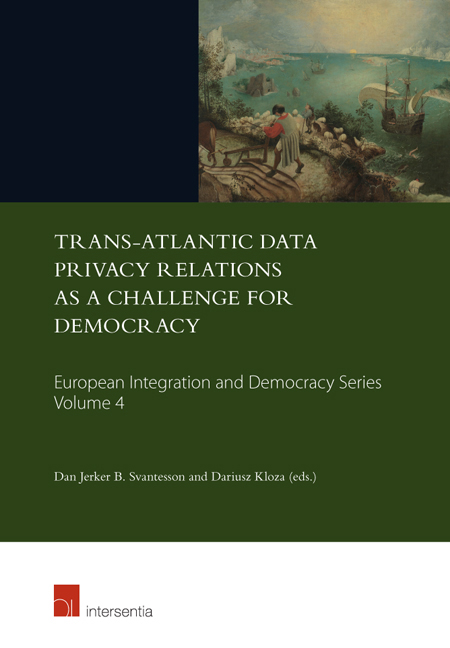Book contents
- Frontmatter
- Foreword
- Preface
- Contents
- List of Abbreviations
- PART I PRIVACY AND …
- SECTION I PRIVACY AND TRANSBORDER FLOWS OF PERSONAL DATA
- 1 Transnational Data Privacy in the EU Digital Single Market Strategy
- 2 Principles for US–EU Data Flow Arrangements
- 3 The Role of Proportionality in Assessing Trans-Atlantic Flows of Personal Data
- 4 US Surveillance Law, Safe Harbour and Reforms Since 2013
- INVITED COMMENTS
- SECTION II PRIVACY AND INTERNATIONAL TRADE
- INVITED COMMENT
- SECTION III PRIVACY AND TERRITORIAL APPLICATION OF THE LAW
- SECTION IV PRIVACY AND CRIME
- INVITED COMMENTS
- SECTION V PRIVACY AND TIME INVITED COMMENTS
- PART II THEORY OF PRIVACY
- PART III ALTERNATIVE APPROACHES TO THE PROTECTION OF PRIVACY
- INVITED COMMENT
- CONCLUSION
3 - The Role of Proportionality in Assessing Trans-Atlantic Flows of Personal Data
from SECTION I - PRIVACY AND TRANSBORDER FLOWS OF PERSONAL DATA
Published online by Cambridge University Press: 29 September 2018
- Frontmatter
- Foreword
- Preface
- Contents
- List of Abbreviations
- PART I PRIVACY AND …
- SECTION I PRIVACY AND TRANSBORDER FLOWS OF PERSONAL DATA
- 1 Transnational Data Privacy in the EU Digital Single Market Strategy
- 2 Principles for US–EU Data Flow Arrangements
- 3 The Role of Proportionality in Assessing Trans-Atlantic Flows of Personal Data
- 4 US Surveillance Law, Safe Harbour and Reforms Since 2013
- INVITED COMMENTS
- SECTION II PRIVACY AND INTERNATIONAL TRADE
- INVITED COMMENT
- SECTION III PRIVACY AND TERRITORIAL APPLICATION OF THE LAW
- SECTION IV PRIVACY AND CRIME
- INVITED COMMENTS
- SECTION V PRIVACY AND TIME INVITED COMMENTS
- PART II THEORY OF PRIVACY
- PART III ALTERNATIVE APPROACHES TO THE PROTECTION OF PRIVACY
- INVITED COMMENT
- CONCLUSION
Summary
INTRODUCTION
Security and law enforcement agencies have become reliant on the mass collection and analysis of data, especially personal data or potentially personal data, as an investigative tool, and oft en as a tool of first recourse The mass collection and processing of data is, moreover, notionally independent of the geographical or legal jurisdiction in which the data originates These evolving practices give rise to considerable difficulties in determining the appropriate balance between national security and law enforcement objectives, on the one hand, and the protection of fundamental rights, on the other Under the law of the European Union (the EU), the principle of proportionality is the single most important legal concept in establishing the balance between public interests, especially the interest in national security, and the fundamental rights to privacy and data privacy There are, nevertheless, significant complexities – both conceptual and practical – and unresolved issues, in satisfactorily applying this contested principle to rapidly changing social and technological circumstances, such as surveillance practices These difficulties are exacerbated where surveillance practices cut across legal borders, including where data is transferred from one legal territory to another, such as occurs with trans-Atlantic flows of personal data.
In Maximillian Schrems v Data Protection Commissioner (‘Schrems’), the Court of Justice of the European Union (CJEU) ruled that the Commission decision on the Safe Harbour Agreement, which effectively authorised flows of personal data from the EU to the US, was invalid The Court invalidated the decision on the basis that, contrary to Art 25(1) of the 1995 Data Protection Directive (DPD), the agreement failed to provide an adequate level of protection for personal data Underpinning this conclusion, however, were concerns with the disproportionate mass and indiscriminate collection and access to personal data (including data originating in the EU) by US intelligence agencies, as revealed by the whistle-blower, Edward Snowden While these US practices complied with the Safe Harbour Agreement, the Court, in effect, held that such widespread, unconstrained surveillance would breach the fundamental rights to privacy and data privacy guaranteed by EU law which, under CJEU jurisprudence, must be protected to a ‘high level’ .
- Type
- Chapter
- Information
- Publisher: IntersentiaPrint publication year: 2017

